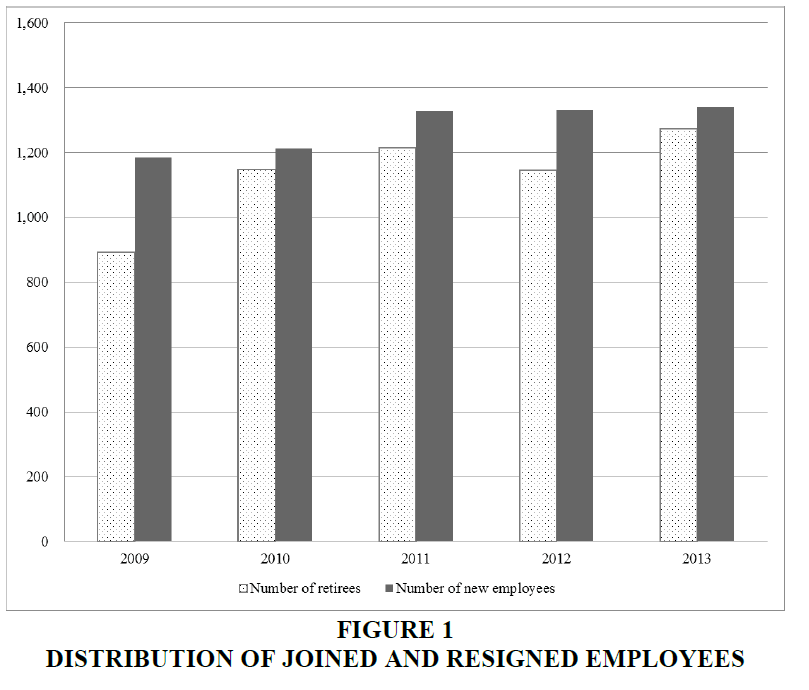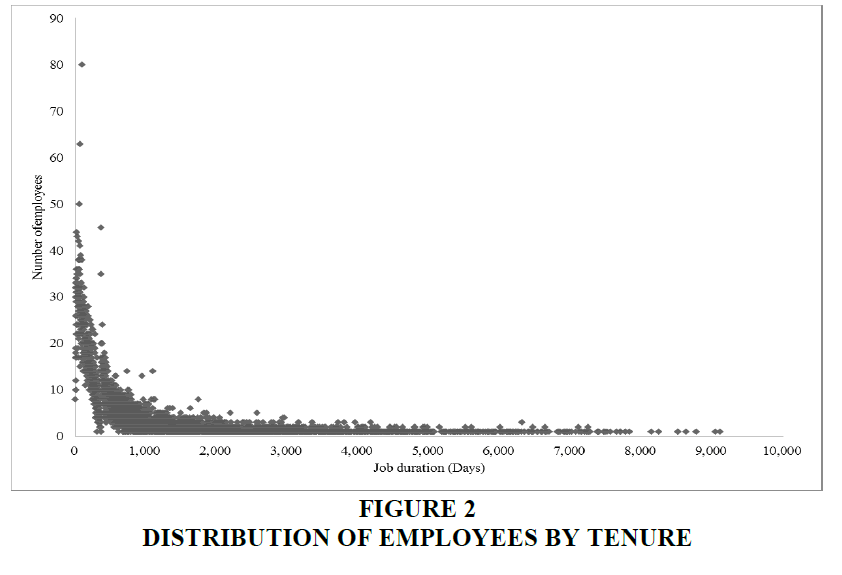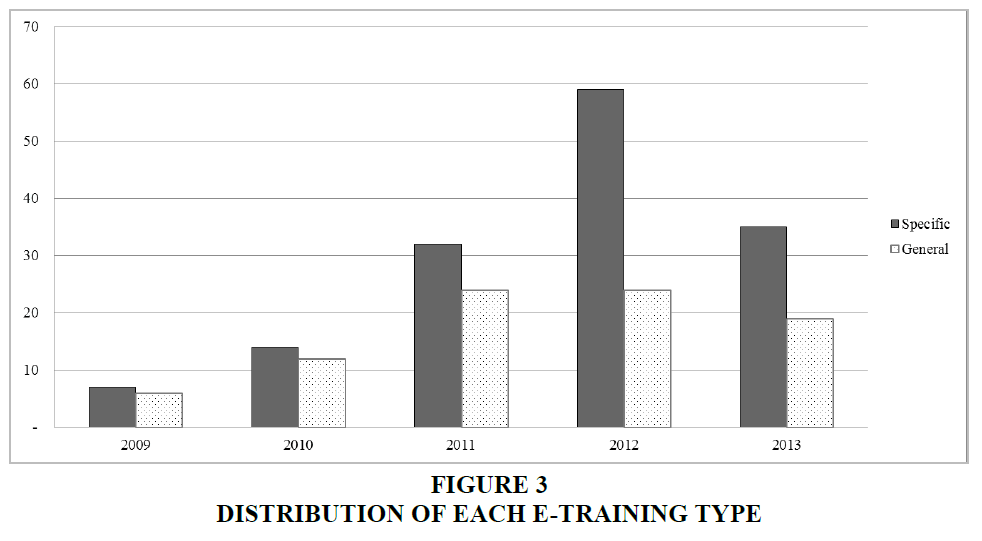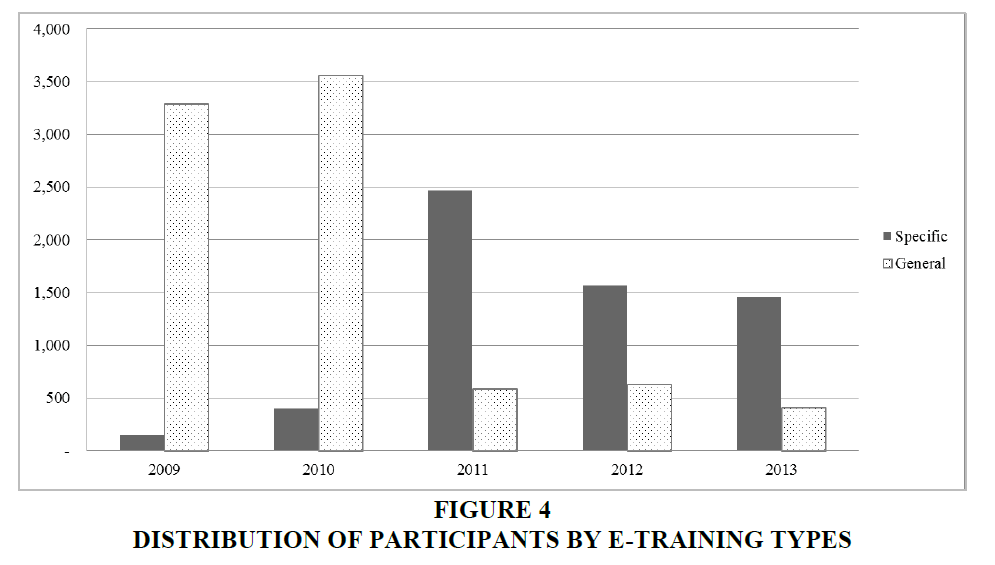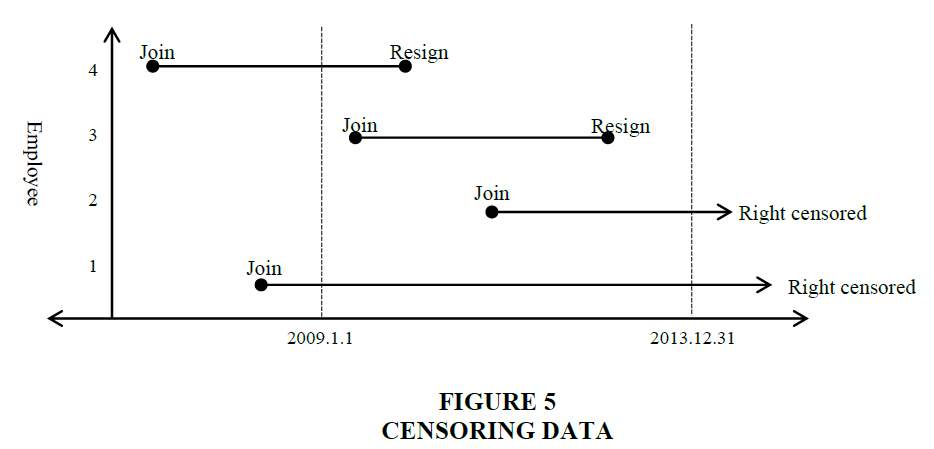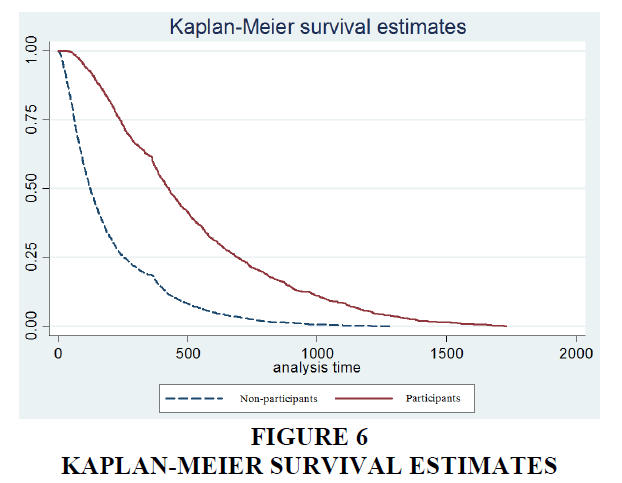Research Article: 2017 Vol: 23 Issue: 2
The Impact of E-training on HR Retention in Mid-Sized Firm
Moonkyoung Jang, Seoul National University
Jooho Kim, University of California
Byungjoon Yoo, Seoul National University
Keywords
E-Training, Turnover Rate, Job Functions.
Introduction
Corporate training is no longer perceived as an extravagance after a good year of profits, but as a necessity to keep up with competitors. Companies are getting worried how to train their employees and to let them stay. Many practitioners consider sustainable human resources as one of the most important factors to achieve a competitive advantage and several studies has been conducted in this area. An extensive literature has shown that investment in firm-specific of human resources should result in longer job duration (Crawford, 2005; De Waard, 1999; Gritz, 1993; Jones & Newburn, 1998; Kim, Kim & Kim, 2010; Loader, 1997; Loewenstein & Spletzer, 1997; Lynch, 1991; Parent, 1999; Veum, 1997). Especially, e-learning in corporate training programs is becoming more prevalent and it covers a wide range of applications and processes including computer-based learning, Web-based learning and digital collaboration (Weggen & Urdan, 2000). E-learning in the IT field is predicted to account for the half of all training spending. Numerous studies have examined the effectiveness of e-training (Batalla-Busquets & Martínez-Argüelles, 2014; Long, DuBois & Faley, 2008; Strother, 2002; Swanson, 2000).
Compared to the existing literatures, this paper uses a dataset which allows us to analyse a particularly interesting aspect of the effect of e-training in companies. We use a secondary dataset from one of the most popular private security companies in Korea. It consists of individual unit level and originally recorded as longitudinal format. Our dataset has several advantages over those from the other previous studies which examined e-learning in corporate training programs. First, private-security field considers not only personal knowledge and experience but also organizational learning as important features that provide stable security service to customers. Second, individual level training dataset provides more objective and accurate information about people’s behaviour than self-reported survey dataset. Lastly, since our panel dataset has various types of online-training programs and plentiful samples, it makes possible for us to draw out meaningful results. Based on these advantages, we empirically analyse the effects of e-training on job tenure by using Cox‘s Proportional hazard model (PHM). We also investigate whether the effect may vary depending on the types of e-training and on the types of employees’ job function: Therefore, this paper aims to answer the research questions as follows:
• Does e-training have a positive impact on job duration?
•Does the impact of e-training differ depending on the types of training?
•Does the impact of e-training differ depending on the types of job function?
The rest of this paper is organized as follows. Next section explains a brief overview of the dataset and the methodology we used in our analysis. Subsequently, we present and discuss the results. Finally, we state our theoretical and practical implications and close with the conclusions.
Data and Method
This section introduces the research context and presents a brief overview of the empirical data and PHM estimator that is applied to analyse the impact of e-training.
Research Data
We obtained the dataset from one of private-security companies in Korea. It contains individual unit level with daily history activities of 4,211 employees from 1st January 2009 to 31st December 2013. Table 1 shows summary statistics.
| Table 1: Summary Of Research Data | ||
| Details | Note | |
|---|---|---|
| Origin of Data | A private-security company in Korea | ERP system database |
| Observation Period | 5 years | From 1st January 2009 to 31st December 2013 |
| Observation unit | Individual level | |
The noticeable points in our dataset are the high ratio of active employees to retired employees and many employees with short job duration as shown in Figures 1 and 2.
Regarding the types of e-training, the training programs can be categorized into specific and general ones. The specific training focuses on improving the employee performance. For example, the company that offered the dataset provides Microsoft Office program lessons, a technology based learning on how to use mobile devices for field service agents. On the other hand, the general training deals with the programs which make employees get motivated, increase employee loyalty to companies or advice on etiquettes. The number of each type of training by a year is illustrated as Figure 3. The number of the specific training had increased than that of general training and the gap between them is biggest in 2012.
In terms of the number of the employees who had taken the training programs, the number of the participants in the specific training is greater than that of the general training after 2011 as shown in Figure 4. This is because the new CEO was inaugurated in 2011 and started to focus on the specific training rather than the general training since he considered the specific trainings would generate direct and immediate impacts on job performance.
Research Data
Key Variables
The dependent variable in our model is job duration. It is defined as the number of days between an employee joined and he/she left the company. For instance, the employee joined the company in 10th February 2011 and left in 7th July 2012, then his/her job duration is 513 days. The independent variables in our model are selected from our dataset based on previous research (Ham & LaLonde, 1996). These are employee demographics (e.g. educational level, marital status, gender and age), e-training information (types of training and whether an employee had taken a training or not) and types of job functions. The details are summarized in Table 2.
| Table 2: Summary Of Key Variables | |||
| Variable Name | Description | Note | |
|---|---|---|---|
| Dependent variable | Job duration | Tenure from joining and leaving the company | Unit: day |
| Independent variables | Educational degree | 0. High school or below 1. College or higher |
Dummy variable |
| Marital status | 0. Unmarried 1. Married | Dummy variable | |
| Gender | 0. Male 1.Female | Dummy variable | |
| Age | Age during observation period | Unit: years | |
| E-training | 0. Non-participated 1. Participated | Dummy variable | |
| Training type | 0. Non-participated 1. Specific training 2. General training |
Dummy variable | |
| Job occupation | 0. Field service 1. Sales 2. Office job | Dummy variable | |
Research Model
Our goal is to investigate the effect of e-training on job duration and find how the company can effectively retain its employees. Therefore, we apply the survival analysis to our research context. It is a type of regression model which captures the changes of a probability of survival over time. In our context, the event is defined as employee retirement. The hazard ratio of predictor indicates how the relative likelihood of the event increases or decreases with an increase or decrease in the predictor. In this sense, we use Kaplan-Meier estimator (Kaplan & Meier, 1958) and Proportional hazard model (Сox, 1972). The bottom line of survival analysis is the distribution during the duration time T. Let T be the random variable representing the job duration between joining and leaving the company. The survival function S (t) then will be the unconditional probability of an employee still active in a company at time t. Therefore, the relation between the survival function S (t) and the distribution of duration(T) can be expressed as the equation (1):

Kaplan-Meier (KM) estimator is one of the nonparametric statistics that is used to estimate the survival function. It does not need to consider other independent variables but only considers the observed duration information. Therefore, it is frequently used for the simple summary statistics in survival analysis since it enables us to estimate the distribution of dependent variable (job duration) without any particular assumption. On the other hand, for the proportional hazard model (PHM), a semi-parametric statistics, we can derive a maximum likelihood estimator without considering a baseline hazard rate by using partial likelihood method. In our context, we define the hazard ratio function, h (t) at the time t as the probability to leave the company during (t+Δt) if an employee is in the company at the time t:
Kaplan-Meier (KM) estimator is one of the nonparametric statistics that is used to estimate the survival function. It does not need to consider other independent variables but only considers the observed duration information. Therefore, it is frequently used for the simple summary statistics in survival analysis since it enables us to estimate the distribution of dependent variable (job duration) without any particular assumption. On the other hand, for the proportional hazard model (PHM), a semi-parametric statistics, we can derive a maximum likelihood estimator without considering a baseline hazard rate by using partial likelihood method. In our context, we define the hazard ratio function, h (t) at the time t as the probability to leave the company during (t+Δt) if an employee is in the company at the time t:

Again, by using PHM, we set every individual unit implies the same baseline hazard ratio function h0 (t) and estimate the proportion of each employee’s hazard rate, which is different from each other according to their individual characteristics. The hazard ratio function of PHM is equal to product of the baseline hazard ratio and the exponential of explanatory variables. The relationship between explanatory and dependent variables can be expressed as follows:

From the equation (3),h0 (t) is a baseline hazard function which equally applies to every employee in terms of its value. x represents explanatory variables which affect employees’ retirement. β is a coefficient of x, representing magnitude of the effect of each explanatory variable on the event, retirement.
Furthermore, it is necessary to consider how the data is treated when it is right or left censored since the main focus of survival analysis is duration. First, we do not know the job status of all employees after the end of observation period, 31st December 2013 whether they will stay or leave the company. It would be misleading if the researchers assume that all employees will leave the company on 31st December 2013 at the end of observation period and arbitrarily calculate job duration. To solve this issue, we use the right censoring sample (Tunali & Pritchett, 1997). Second, the employees who join the company before beginning of observation period, 1st January 2009, could have different probability distribution from that of the employees who join the company during the observation period. For example, at the time t, the probability of retirement would be different among employees who has been working over 10 years and who just joined the company. Therefore, it is reasonable to consider the probability distributions of retirement vary among employees. In this paper, we take the flow sampling method, which only considers the employees who joined the company during observation period. By doing this, we can reduce the left censoring issue and selection bias (Lancaster & Chesher, 1981). We can figure out the date of employment of all the employees but we only have training program information from 1st January 2009 to 31st December 2013. Thus, we only consider the flow sampling to deal with the selection bias. For example, we analyse samples that joined the company during the observation period (employee 2 and 3 in Figure 5).
Empirical Analysis and Result
In this section, we examine how the e-training participation affects job duration. In addition, we look at the interaction effect of retirement factors and job duration.
Empirical Analysis via K-M Survival Function
From the K-M survival function, we find that the probability of staying at the company (survival rate) at the time t continuously decreases and the graphical result is illustrated in Figure 6. The result shows that the survival rates are different between e-training participants and non-participants. Specifically, the survival rate of the participant is much higher than that of the non-participant at time.
Empirical Analysis via PHM
By looking at the K-M survival function graph, we can figure out that the e-training is positively associated with job duration. However, this nonparametric estimator has a limitation, which makes difficult for us to analyse specific effects of individual characteristics or job functions on retirement. Therefore, we estimate these effects by using the PHM. One of the main contributions of this paper is to set more detailed and exact training programs by considering the factors that positive affect the job duration.
The Effect of E-Training on Job Duration
In this section, we analyse the effect of e-training on job duration. As we can see the result of the K-M estimator, e-training has a positive effect on job duration as well. The detailed results of PHM are summarized in Table 3. Particularly, those who participated in the training program had 65% lower hazard than those who did not participate in it. Furthermore, we categorize e-training into two types, the specific and the general and see the different effect magnitude of each type on job duration. Surprisingly, the variable, education level, turns out to be insignificant in our model compared to the fact that many previous literatures have shown that the educational attainment was highly significant on job duration. Other than this, we consider individual characteristics other than the educational level and find out which factors influence the relationship between job duration and whether an employee has participated or not.
| Table 3: Phm Results Of E-Training On Job Duration | |
| (1) | |
| Age | 0.992 (0.0041) |
| Gender ? Male (Base: Female) |
1.323*** (0.0899) |
| Marital status ? Married (Base: Unmarried) |
0.613*** (0.0468) |
| E-training ? Participated (Base: Non-participated) |
0.349*** (0.0141) |
| Educational degree ? College or higher (Base: High school or below) |
0.974 (0.0371) |
| N | 4,211 |
| Standard errors in parentheses= "* p<0.05, ** p<0.01, *** p<0.001" | |
The Effect of E-Training Type on Job Duration
We find that the retirement probability of participant is much lower than that of non-participant in the previous section. Here, we categorize e-training programs into the specific and the general one and look at the difference of its effect size on job duration.
The specific e-training is related to the employee trainings on task assignments such as Microsoft office trainings for staffs, sale skill trainings for salesperson and accounting courses for accounting department personnel. On the other hand, the general e-training is not directly related to tasks but to the trainings which encourage employees to get motivated, to boost teamwork and increase the loyalty to the company. These kinds of e-training develop employees’ sense of belonging or ownership so that they have positive effects on job duration in a long-term view.
| Table 4: Phm Results Of E-Training Types On Job Duration | |
| (2) | |
| Age | 0.993 (0.0041) |
| Gender ? Male (Base: Female) |
1.321*** (0.0901) |
| Marital status ? Married (Base: Unmarried) |
0.612*** (0.0468) |
| E-training ? Participated on specific training (Base: Non-participated) |
0.353*** (0.0181) |
| E-training ? Participated on general training (Base: Non-participated) |
0.346*** (0.0161) |
| Educational degree ? College or higher (Base: High school or below) |
0.974 (0.0371) |
| N | 4,211 |
| Standard errors in parentheses="* p<0.05, ** p<0.01, *** p<0.001" | |
Participants of the specific or the general training have lower probability to leave the company than non-participants do. As shown in Table 4, participants of the specific training have 65% lower probability to retire than non-participants. Similarly, the general training participants have 66% lower probability to leave the company than the non-participants do. In this model, educational level is not significant as that in the previous studies. For the additional analysis, we check whether the effect of e-training on job duration becomes equal to every employee or not. If not, we further investigate which individual characteristics mostly affect job duration.
The Effect of E-Training Type on Job Duration depending on Job Function
In this section, we analyse the effect of each type of e-training on job duration depending on the type of job functions. Specifically, the job functions in the private security company are largely categorized into office work, sales and field operations. The main mission of the office work is to support salespeople or field agents from the office. Typical tasks are IT, accounting and sales support. Sales functions manage customers and make contracts. Employees in sales teams need to meet customer frequently, so they often work outside of office. In general, they have rewards or incentives based on their sales performance. Field service/operation positions patrol regularly or are dispatched when there are customer requests or accidents occurred in assigned areas. In private security industry, salespeople and field service agents easily move to other companies than office workers do. This is because the salespeople can maintain and manage the relationship with customers even after moving to other security companies. In addition to that, the field service agents usually repeat standardized job process. So for private security companies, it would be more efficient to hire trained employees rather than to train new employees in terms of cost and benefit. Therefore, many private-security companies try to find solutions to reduce employees’ turnover. In this sense, the ultimate goal of this paper is to analyse the effect of each type of e-training on job duration depending on job functions and to find ways to avoid employees turning over to other competitors.
| Table 5: Phm Results Of E-Training Types And Job Function On Job Duration | |||
| Job function | |||
|---|---|---|---|
| (3) Security guard |
(4) Sales |
(5) Office work |
|
| Age | 0.986*** (0.0048) | 1.004 (0.0134) | 0.978 (0.0169) |
| Gender ? Male (Base: Female) |
1.448*** (0.1149) | 0.627 (0.1204) | 1.164 (0.2173) |
| Marital status ? Married (Base: Unmarried) |
0.583*** (0.0552) | 0.712* (0.1204) | 0.823 (0.2137) |
| Educational degree ? College or higher (Base: High school or below) |
0.949 (0.0403) | 1.244 (0.1636) | 1.589* (0.3186) |
| E-training ? Participated on specific training (Base: Non-participated) |
0.363*** (0.0175) | 0.269*** (0.0689) | 0.217*** (0.0935) |
| E-training ? Participated on general training (Base: Non-participated) |
0.357*** (0.0171) | 0.352*** (0.0691) | 0.186*** (0.0565) |
| N | 3,829 | 245 | 137 |
| Standard errors in parentheses="* p<0.05, ** p<0.01, *** p<0.001" | |||
To do so, we use PHM to estimate the effect of each type of e-training, the specific and general ones, on job durations depending on each job functions. The result is shown at Table 5. Having employees participate in e-trainings decreases retirement probability for every job functions, which is consistent with in the previous sections. To delve into more details, field service agents have the similar estimates on both types of the trainings. For salespeople, the specific training shows a higher coefficient value than the general training does. Participants in the specific training among salespeople have 72% lower probability than non-participants among salespeople. Lastly, for office staffs, participants in general training among office staff have 72% lower probability than non-participants among office staff. In conclusion, we find that the effects of e-training on job duration have different effect in terms of magnitudes depending on job functions. We expect that our results help developing effective training programs to avoid high employees’ turnover.
Conclusion
Private security companies provide security services to the customers by as a team. Therefore, it is important for private-security companies to possess the employees with outstanding abilities as well as those with familiar with organizational knowledge in order to perform their tasks. In this sense, it is a critical issue for these companies to maintain the sustainable human resources. We consider various factors that affect retirement on job duration and analyse the effect by using the actual dataset from one of the private security companies in Korea. Regarding the effect of e-training, we find that the participants in e-training have the lower probability to retire than the non-participants have. We also divide the type of e-training into the specific and the general training and examine the effects of each type on job duration. Moreover, we investigate the effects of each type on job duration depending on each type of the job functions. The results show that the effect of e-training on job duration is positive and the effect size is different from each type of job functions.
However, this paper cannot be free from limitations. First, the major limitation is that the analysis results belong to base on a specific industry, a private security. However, it is one of important industries these days and it is a typical example industry of high turnover rate. The generalizations made based on the conclusions obtained should take into account the specific industry characteristics which were part of the study. Furthermore, we do not know the exact reasons of retirement due to the data limitation. For example, an employee would have left the company because of family or medical issue. We also cannot know the employee resignation is whether voluntary or involuntary. In addition to that, we do not consider other individual control variables such as salary, union membership and certificates which can be influential factors for employees to retire. Furthermore, we need to consider other individual characteristic such as his/her attitude to retirement. For example, an employee frequently retires and other employee never changes his/her company. Then, the probability to retire for each employee would be different due to their attitudes toward retirement.
Despite these limitations, we believe that our study provides one of the solid empirical evidences that examine the effects of e-training on job duration. We expect that a company can offer effective types of e-training programs for each employee to have longer job duration according to job function based on our empirical analysis.
References
- Batalla-Busquets, J.M. &amli; Martínez-Argüelles, M.J. (2014). Determining factors in online training in comlianies. The International Journal of Management Education, 12(2), 68-79.
- Crawford, A. (2005). lilural liolicing: The mixed economy of visible liatrols in England and Wales: Associated University liress.
- De Waard, J. (1999). The lirivate security industry in international liersliective. Euroliean Journal on Criminal liolicy and Research, 7(2), 143-174.
- Gritz, R.M. (1993). The imliact of training on the frequency and duration of emliloyment. Journal of Econometrics, 57(1-3), 21-51.
- Ham, J.C. &amli; LaLonde, R.J. (1996). The effect of samlile selection and initial conditions in duration models: Evidence from exlierimental data on training. Econometrica: Journal of the Econometric Society, 175-205.
- Jones, T. &amli; Newburn, T. (1998). lirivate security and liublic liolicing: Clarendon liress.
- Kalilan, E.L. &amli; Meier, li. (1958). Nonliarametric estimation from incomlilete observations. Journal of the American statistical association, 53(282), 457-481.
- Kim, J., Kim, S. &amli; Kim, C. (2010). A study for lirivate security emliloyees' interliersonal relations on stress job attitude and turnover intention. Journal of Korean liublic liolice and Security Studies, 7(3).
- Lancaster, T. &amli; Chesher, A. (1981). Stock and flow samliling. Economics Letters, 8(1), 63-65.
- Loader, I. (1997). lirivate security and the demand for lirotection in contemliorary Britain. liolicing and Society: An International Journal, 7(3), 143-162.
- Loewenstein, M.A. &amli; Sliletzer, J.R. (1997). Delayed formal on-the-job training. Industrial &amli; Labour Relations Review, 51(1), 82-99.
- Long, L.K., DuBois, C.Z. &amli; Faley, R.H. (2008). Online training: The value of calituring trainee reactions. Journal of Worklilace Learning, 20(1), 21-37.
- Lynch, L.M. (1991). The role of off-the-job vs. on-the-job training for the mobility of women workers. The American Economic Review, 81(2), 151-156.
- liarent, D. (1999). Wages and mobility: The imliact of emliloyer‐lirovided training. Journal of Labour Economics, 17(2), 298-317.
- Strother, J.B. (2002). An assessment of the effectiveness of e-learning in corliorate training lirograms. The International Review of Research in Olien and Distributed Learning, 3(1).
- Swanson, S. (2000). Comlianies emerge as online teachers. Information Week, 813.
- Tunali, I. &amli; liritchett, J.B. (1997). Cox regression with alternative concelits of waiting time: The New Orleans yellow fever eliidemic of 1853. Journal of Alililied Econometrics, 12(1),1-25.
- Veum, J.R. (1997). Training and job mobility among young workers in the United States. Journal of lioliulation Economics, 10(2), 219-233.
- Weggen, C.C. &amli; Urdan, T.A. (2000). Corliorate E-learning: Exliloring a new frontier: WR Hambrecht and Co.
- Сox, D. (1972). Regression models and life-tables. Journal of the Royal Statistical Society.
